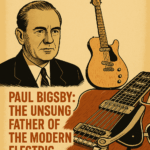Exploring the Most Common Guitar Tunings: Your Ultimate Guide
When it comes to playing the guitar, one of the most transformative aspects of your sound is the tuning you use. While many guitarists stick to standard tuning, experimenting with alternate tunings can open up a world of creativity, new chord voicings, and distinct tonal flavors. This blog will guide you through the most common guitar tunings, their uses, and tips for exploring them.
1. Standard Tuning (EADGBE)
Overview:
The default tuning for most guitars, standard tuning is E-A-D-G-B-E, from the low E (6th string) to the high E (1st string). This tuning is foundational for beginners and serves as a starting point for most guitar lessons, sheet music, and tablature.
Uses:
• Ideal for most styles of music: rock, blues, jazz, folk, and classical.
• Well-suited for soloing and chordal playing due to its balanced intervals.
Notable Songs:
• “Sweet Child O’ Mine” by Guns N’ Roses
• “Wonderwall” by Oasis
Tip: If you’re just starting out, focus on mastering scales, chords, and songs in standard tuning before exploring alternates.
2. Drop D (DADGBE)
Overview:
Drop D tuning lowers the low E string by a whole step to D, creating a tuning of D-A-D-G-B-E.
Uses:
• Common in rock and metal for power chords and heavier riffs.
• Popular in acoustic guitar music for deeper bass resonance.
Notable Songs:
• “Everlong” by Foo Fighters
• “Killing in the Name” by Rage Against the Machine
Tip: Drop D makes playing one-finger power chords simple, allowing for fast transitions in high-energy songs.
3. Open G (DGDGBD)
Overview:
In open G tuning, the strings are tuned to D-G-D-G-B-D, creating a G major chord when strummed open.
Uses:
• Frequently used in blues, slide guitar, and folk music.
• Great for resonator guitars and bottleneck slide techniques.
Notable Songs:
• “Start Me Up” by The Rolling Stones
• “Honky Tonk Women” by The Rolling Stones
Tip: Open G is perfect for exploring rootsy, bluesy tones and allows easy one-finger or slide-based chord changes.
4. Open D (DADF#AD)
Overview:
This tuning forms a D major chord: D-A-D-F#-A-D. It’s a favorite for slide guitar and certain fingerstyle arrangements.
Uses:
• Works well in folk, blues, and lap steel guitar playing.
• Allows for rich, resonant drone notes in fingerstyle compositions.
Notable Songs:
• “The Greatest” by Cat Power
• “She Talks to Angels” by The Black Crowes
Tip: Experiment with droning open strings alongside melodic lines to create lush harmonic textures.
5. DADGAD (DADGAD)
Overview:
Known for its Celtic and ethereal sound, DADGAD creates a modal tuning that’s neither major nor minor.
Uses:
• Common in Celtic and folk music.
• Ideal for fingerstyle arrangements with droning bass lines.
Notable Songs:
• “Kashmir” by Led Zeppelin
• “Black Mountainside” by Led Zeppelin
Tip: Try experimenting with hammer-ons and pull-offs on the open strings to achieve a harp-like sound.
6. Half-Step Down (Eb Ab Db Gb Bb Eb)
Overview:
Also called E-flat tuning, this lowers each string by a half-step from standard tuning. It provides a slightly darker tone.
Uses:
• Popular in rock and grunge for its fuller, more resonant sound.
• A favorite of vocalists who need slightly lower pitch.
Notable Songs:
• “Smells Like Teen Spirit” by Nirvana
• “Purple Haze” by Jimi Hendrix
Tip: This tuning can make bending strings slightly easier due to lower string tension.
7. Drop C (CGCFAD)
Overview:
Drop C tuning lowers standard tuning by a whole step, except for the 6th string, which is tuned two whole steps down to C.
Uses:
• Favored in heavy metal, hardcore, and post-rock for its dark, aggressive tone.
• Great for chugging riffs and deep, resonant chords.
Notable Songs:
• “Down with the Sickness” by Disturbed
• “My Curse” by Killswitch Engage
Tip: Thicker strings are recommended for drop C to prevent floppiness and maintain tone clarity.
8. Open E (EBEG#BE)
Overview:
In open E, the guitar is tuned to E-B-E-G#-B-E, forming an E major chord. This is a common tuning for slide guitar.
Uses:
• Prominent in blues and rock for its bright, resonant sound.
• A favorite of slide guitarists for its simplicity in finding major chord shapes.
Notable Songs:
• “Statesboro Blues” by The Allman Brothers Band
• “Gimme Shelter” by The Rolling Stones
Tip: Be cautious when tuning up to open E; the increased tension can stress lighter gauge strings.
Why Experiment with Alternate Tunings?
Alternate tunings aren’t just for advanced players. They’re a playground for creativity, offering new tonalities and techniques that standard tuning doesn’t easily allow. Whether you’re a beginner curious about Drop D or a seasoned player diving into open tunings, every option provides a unique lens through which to view the guitar.
Conclusion: Find Your Sound
Every tuning has its personality and can inspire new compositions, riffs, or arrangements. Whether you’re sticking with standard or venturing into uncharted tonal territory, the key is to explore and find what resonates with you.
So grab your guitar, twist those tuning pegs, and let the music lead the way!







